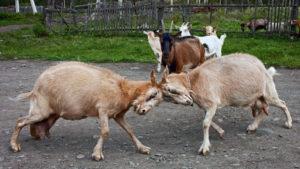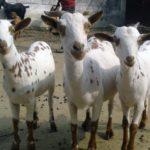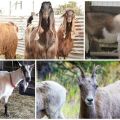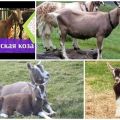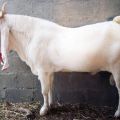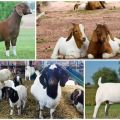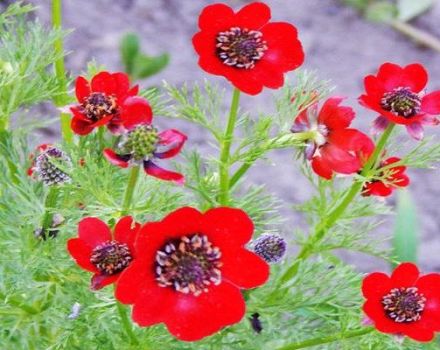Description and characteristics of Bital goats, rules of care and maintenance
Dairy goats are always in demand. Bital is an unpretentious breed of goat that is not often found on farms. The main value of the breed is high-calorie milk, which is pleasant to drink fresh, since there is no specific smell. Also, delicious cheeses and cottage cheese are prepared from fatty milk. A big plus of bital goats is omnivorousness.
The origin and significance of the breed
Areas of North India and Pakistan are considered the birthplace of Bital goats. Getting fat milk (about 5.03%) is the main goal of animal breeding. The increased calcium content increases the health benefits of milk for people with arthritis. It is noteworthy that milk does not have a specific goat smell, is very nutritious and suitable for consumption by persons suffering from allergies to cow's milk. On average, 170 liters of milk are poured from one individual. The highest productivity of goats begins after the fourth or fifth lactation.
Bital is also bred for the purpose of obtaining meat, since the weight of the male and female can reach 65 and 45 kg, respectively. But still, the self-sufficiency of goats is higher when raising dairy animals.
Description and characteristics
Bital goats have an average build, but males grow much larger than females. The body is massive with small stature. On the neat head, a large nose of the "Roman" profile stands out in a peculiar way. Beats have long legs, small tail. A distinctive feature of the breed is the long hanging ears. The coarse coat grows in medium length and does not have a specific shade characteristic of the breed. There are individuals of black or white color, golden brown with white pigmentation.
Horns of a spiral type, turned back, grow in both males and females. But in goats, the horns grow shorter. Goats begin to give birth from the age of just under two years. In a year, one individual bears one or two kids.

Main advantages and disadvantages
Bitals are distinguished by their endurance and the ability to develop normally in various conditions. Other positive qualities of the breed deserve attention:
- animals are omnivorous. They are not at all capricious in the choice of feed, they perfectly eat thin branches and straw;
- goats fully develop on open pastures and in a closed farm;
- with good care, the daily milk yield is 4-6 liters of milk;
- high-calorie milk can be consumed fresh and mixed with cow or sheep milk to obtain all kinds of cheese;
- goats are suitable for farms where there is no grazing area.
This breed is not often found on farms. The main disadvantage of bital goats is their high cost. It should also be borne in mind that natural habitats are warm countries, so animals do not tolerate low temperatures well.

Maintenance and care rules
A draft-free, ventilated, dry and clean room is suitable for raising livestock. When planning a goat's rue, a cage with an area of 2-25 sq. M is allocated to the queen with the kids, 2 sq. M. To the goat, and 1.5 sq. M. To single queen bees. Each cage must be equipped with a feeder. For feeding vegetables, thick mash buckets are used, which are left next to the feeder.
It is not recommended to make a concrete floor, as the hard surface increases the humidity in the room. A wooden covering is better, but a layer of straw 20-25 cm thick is laid on top. In winter, the temperature in the goat's house should not fall below 6-8 ° C. When newborns appear, the temperature should be 9-11 ° C.
Animals should be examined regularly. The contaminated coat is cut, the hooves are periodically carefully trimmed. For milking, certain hours are allocated. The best option is one hour after feeding. If the kids are taken away from the uterus, then milk is milked 4-5 times a day. Be sure to wash the udder before milking.
What to feed the animal
If goats are reared for commercial purposes (to obtain high-quality fat milk), then the issue of diet is of particular importance. When choosing feed, take into account the season:
- in winter, the basis of the diet is roughage at the rate of 1.5-2.5 kg per day. Be sure to add meadow or forest hay to the diet (450-500 kg for an adult). Sometimes hay is replaced with birch, poplar, willow brooms with leaves (3-5 pieces per day);
- in summer, the goat is best grazed in pastures. The animal eats about 7-8 kg of grass per day. The animal kept in the pen is fed 7-8 kg of cut grass, additionally given beet, carrot, cabbage leaves.
The feeding schedule has a significant effect on milk volume. It is recommended for the bital goats to organize three meals a day (in the morning at 6-7 hours, lunch at 12-13 hours, dinner at 18-19). If the ration of one feeding consists of different types of feed, you need to alternate them. Initially, they feed the mash with compound feed, then juicy feed and end up with coarse food. For dinner, easily digestible feed is poured (a mash with compound feed, root crops). To increase milk production, goats are watered 2-3 times a day (2.5-4 liters of clean warm water at a time).

Breeding subtleties
Bital goats are clean, so it is important to keep the crates dry. When breeding a breed, it should be borne in mind that males become sexually mature at the age of 12-15 months. A female aged 20-22 months is ready to bear offspring. The goat gives birth to a kid weighing 3-3.4 kg. Pregnancy lasts 5 months, lactation period is up to 180 days.
Prevention and treatment of diseases
The emergence and development of diseases is provoked by poor-quality animal maintenance, a meager diet, and non-compliance with quarantine measures. Common diseases in small ruminants:
- mastitis (inflammation of the mammary glands) - refers to non-infectious diseases, treated with antibiotics. Appears in case of udder injuries, improper milking, poor housing conditions. Preventive measures - regular cleaning of the cages, proper care of the udder before and after milking;
- Joint rheumatism occurs when goats are kept in damp, cold rooms. Symptoms: the joints are swollen, the animal has difficulty walking, the appetite decreases. The main treatment - the sore joints are rubbed with special ointments, sodium salicylic acid is given when feeding.Prevention - regular replacement of bedding, insulation of premises.
Infectious diseases deserve special attention, some of which are transmitted to humans (brucellosis). When a disease is detected, patients are isolated. Places of detention are thoroughly disinfected. Preventive measures: constant examination of animals, quarantine keeping of new arrivals, control over the quality of feed and conditions of detention.
Goats are bred for milk, meat, wool. When choosing, preference is given to dairy breeds. Bital deserves the attention of owners of both large-scale farms and small farms. Goats give fat milk, are unpretentious in food and adapt to life in different conditions.
